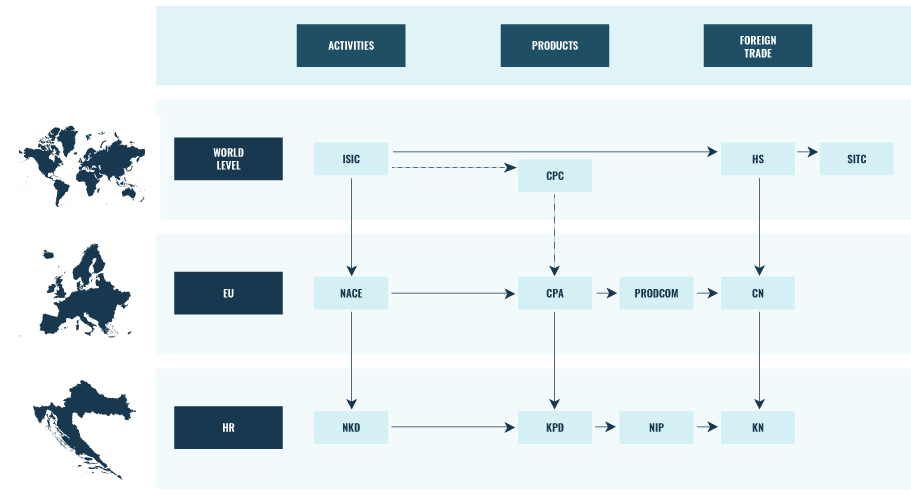Scheme of the International Breakdown of the Integrated System of Classifications of Activities and Products – ISCAP

ISIC
ISIC is an international standard classification of economic activities that enables a classification of units according to activities they perform. The categories of ISIC are delineated at the most detailed level (classes) according to what is, in most countries, the customary combination of activities carried out by statistical units.
ISIC is used for collecting, processing and presentation of statistical data on economic activities at the world level and provides framework for international comparison of national statistics.
Related classifications: SITC, CPC, COFOG, NACE, CPA, HS, NKD, KPD
NACE
NACE is a statistical classification of economic activities in the European Community that provides a framework for collecting and presenting a large number of statistical data according to economic activities, primarily in the fields of economic statistics, but also in other statistical domains.
It has been derived from the International Standard Industrial Classification of All Economic Activities (ISIC) and, although it is more disaggregated than ISIC, it is completely in line with it and can thus be regarded as its European version.
Related classifications: ISIC, CPA, PRODCOM, SITC, CN, NKD, KPD, NIP, NIPUM
CPC
(Central Product Classification) is the central product classification recommended for worldwide use and has five hierarchical levels. It includes both goods and services, with goods being defined on the basis of elements of the Harmonised System. There is no modular relationship to a base classification for the service sector, since the CPC was the first classification to be created (as part of the 1990s revision) that covered all services.
CPA
CPA is a European version of the Central Product Classification of the United Nations (CPC). Whilst CPC is merely a recommended classification, CPA is a legally binding classification in the European Union.
CPA differs from CPC not only in that it is more detailed but also as regards its structure. The structure of CPA is based on the criterion of economic origin of products, with the framework being based on NACE.
Related classifications: ISIC, CPC, HS, NACE, PRODCOM, CN, NKD, KPD, NIP, NIPUM
CN
The Combined Nomenclature (CN) is the goods classification used within the EU for the purposes of foreign trade in goods statistics. It is also used by the Directorate General of the Taxation and Customs Union of the European Commission for customs purposes. The classification is maintained by Eurostat for statistical needs and by DG for Taxation and Customs Union for tariff needs. Having a status of the Council Regulation, it is mandatory for Member States.
The classification is based on the Harmonized System (HS). CN was introduced in 1988 together with HS.
Related classifications: HS, CPC, CPA, ISIC, NACE, SITC, PRODCOM, CT, KPD, NIP, NKD
PRODCOM
PRODCOM is a title of EU production statistics for sections Mining and quarrying, Manufacturing and Electricity, gas and water supply, of the Statistical Classification of Economic Activities in the European Community (NACE).
PRODCOM List headings have been derived from the Harmonized System (HS) or from the Combined Nomenclature (CN), which enables comparisons between production statistics and foreign trade in goods statistics.
PRODCOM headings are coded using an eight-digit code, the first six digits of which are, in general, identical to those of the CPA code. The PRODCOM list is therefore linked to and consistent with the Central Product Classification.